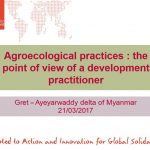
3 downloads
Title of document: Agroecological Practices: the point of view of a development practitioner Authors: Journal’s name if any: Ministry/Government Agency/Organisation: GRET Year of publication: 2017 Geographic focus: Myanmar Main issues / topics addressed (for example: Current Delta program; Gret activities in Delta Challenges for farmers in Delta; AE techniques in Delta ……) School of agroecology (if any): Web address to original document (if any): Summary: This presentation for GRET Ayeyarwaddy delta of Myanmar 21/03/2017 Read More
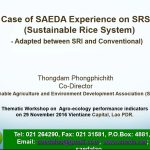
13 downloads
Title of document: Case of SAEDA Experience on SRS (Sustainable Rice System) - Adapted between SRI and Conventional) Authors: Thongdam PHONGPHICHITH Journal’s name if any: Ministry/Government Agency/Organisation: SAEDA Year of publication: 2016 Geographic focus: Lao PDR Main issues / topics addressed (for example: Why we adapted?, Organic SRS Principles……) School of agroecology (if any): Web address to original document (if any): Summary: Presentation for Thematic Workshop on Agro-ecology performance indicators, on 29 November 2016, Vientiane Capital, Lao PDR. Read More
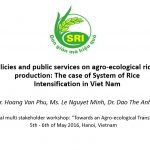
11 downloads
Title of document: Policies and public services on agro-ecological rice production: The case of System of Rice Intensification in Viet Nam Authors: Dr. Hoang Van Phu, Ms. Le Nguyet Minh, Dr. Dao The Anh Journal’s name if any: Ministry/Government Agency/Organisation: SRIViet Year of publication: 2016 Geographic focus: Vietnam Main issues / topics addressed (for example: SRI in the World and Vietnam, Vietnam SRI network (SRIViet)……) School of agroecology (if any): Web address to original document (if any): Summary: System of Rice Intensification (SRI) adoption in 5 countries who produce 2/3 of world’s rice (India, Vietnam, China, Indonesia, Cambodia). About 9.5 million farmers use SRI in 3.4 million ha and estimate value of SRI increased production: $862.5 million. Presentation for National multi stakeholder workshop: “Towards an Agro-ecological Transition”, 5th - 6th of May 2016, Hanoi, Vietnam Read More
9 downloads
Title of document: National Multi-stakeholder Workshop on Agroecological Transition Authors: Stephen Rudgard Journal’s name if any: Ministry/Government Agency/Organisation: ACTAE, CANSEA, SAVE AND GROW, FAO Year of publication: 2016 Geographic focus: Lao PDR Main issues / topics addressed (for example: Save and Grow-SIRP improved management practices promoted in Farmers Field Schools, Field Experiment Design ……) School of agroecology (if any): Web address to original document (if any): http://www.fao.org/ag/save-and-grow/ Summary: The main of this presentation talking about Sustainable Intensification of Rice Production: Ecosystem-based Approaches. At National Multi-stakeholder Workshop on Agroecological Transition in Vientiane, 2 - 3 June 2016 Read More
9 downloads
Title of document: Better rice Initiative Asia Capacity Development for rice cultivation Authors: Henrik Beermann, Astari Widya Dharma Journal’s name if any: Ministry/Government Agency/Organisation: Deutsche Gesellschaft für Internationale Zusammenarbeit (GIZ) GmbH ; On behalf of The German Federal Ministry for Economic Cooperation and Development (BMZ) Year of publication: 2015 Geographic focus: ASIAN Main issues / topics addressed (for example: Capacity building strategy, technical processes of developing the CD strategies for sustainable rice cultivation,……) School of agroecology (if any): Web address to original document (if any): Summary: The German Food Partnership (GFP) aims at fostering the cooperation between private and public sector institutions. Its objective is to promote sustainable growth in agricultural production and improved access to nutrition within the food sector in emerging and developing countries. Public and private actors join forces in order to implement comprehensive projects and programs for sustainable business in these countries. The contribution towards food and nutrition security as well as economic development in rural areas is to be measured by increased agricultural productivity and income, improved availability of nutritious food, and food self-sufficiency. As one of the first concrete initiatives under the GFP umbrella, the Better Rice Initiative Asia (BRIA) is a joint project planned and implemented by private partners in collaboration with GIZ, and public organizations in the respective countries. BRIA aims at improving rice value chains (which include rice based nutrition components) in Southeast Asia (SEA), namely the four SEA countries Indonesia, the Philippines, Thailand, and Vietnam. BRIA’s focus is on strengthening the nutritional and economic situation of rice smallholders, and consumers. The purpose of this document is to provide an overview of the workshop and summarize the main lessons learned and recommendations for good practices of capacity development for sustainable rice cultivation in SEA. Read More
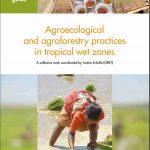
56 downloads
Title of document: Agroecological and agroforestry practices in tropical wet zones Authors: A collective work coordinated by Justine Scholle (GRET) Ministry/Government Agency/Organisation: GRET Year of publication: 2017 Geographic focus: Mekong Region and Central Africa Summary: This guide is designed as a support tool for technicians and farmers involved in actions to promote and develop agroecology. It is a follow-up to a first technical guide published in 2014 in the Democratic Republic of Congo as part of the DEFIV project, a food security project implemented by GRET, funded by the European Union and Agence française de développement. This guide features two parts: The first part presents the current context and issues of agroecology in tropical wet regions. Having demonstrated the limits of conventional agricultural systems, analysed the effects of deforestation, the green revolution and climate change, the authors specify the objectives and the principles of agroecology, and remind readers of the conditions necessary to promote it. The second part is very operational and covers the various agroecological techniques, which were tested in a tropical wet context with satisfying results in the Democratic Republic of Congo (DEFIV project), Cambodia (APICI project) and Myanmar (Delta and NRS projects). Firstly, the various agroecological techniques are presented, and secondly the plants used to implement these techniques are described. Naturally, techniques such as plant inventories mentioned in this guide are not exhaustive. Read More
2 downloads
Title of document: Composite farming systems in an era of change: Nagaland, Northeast India. Authors: Malcolm Cairns and Harold Brookfield Ministry/Government Agency/Organisation: Department of Anthropology, School of Culture, History and Language, ANU College of Asia and the Pacific, The Australian National University, Canberra A.C.T., Australia. Year of publication: 2011 Geographic focus: India Summary: Composite farming systems, first clearly identified by Rambo, are those in which radically different technologies are found together in a single farming complex. Data from diaries kept by groups of farming families in two Angami Naga villages in northeast India, Khonoma and smaller Tsiesema, detailing inputs into and outputs from wet-rice terraces and jhum (swidden) fields in the years 2000 and 2001, are presented and discussed to detail the workings of related but different composite systems. The 2000–2001 survey caught an important set of changes in midstream. Although returns to labour from the first-year jhums were much higher than those from the wet-rice terraces in 2000–2001, jhums were declining in significance as a growing non-farm economy joined the production of cool-climate vegetables and a spice crop for the Indian market as principal sources of livelihood. This story is told in the light of recent writing on the demise of swidden in the larger Southeast Asian region, and it is suggested that greater attention be paid to the composite systems, which are not uncommon in this region. This might help diversify what has perhaps been an oversimplified discussion. Read More
6 downloads
Title of document: Making Rice Production More Environmentally-Friendly Authors: Norman Uphoff and Frank B. Dazzo Ministry/Government Agency/Organisation: SRI International Network and Resources Center, International Programs, College of Agriculture and Life Sciences, Cornell University, Ithaca, NY, USA; Department of Microbiology and Molecular Genetics, Michigan State University, East Lansing, MI , USA. Year of publication: 2016 Geographic focus: Global level Summary: Irrigated rice production is one of the most essential agricultural activities for sustaining our global population, and at the same time, one of the agricultural sectors considered most eco-unfriendly. This is because it consumes a larger share of available freshwater resources, competing with varied ecosystems as well as other economic sectors; its paddy fields are responsible for significant emission of greenhouse gases; and the reliance on chemical fertilizers and various agrochemicals contributes to pollution of soils and water systems. These stresses on soils, hydrology and atmosphere are actually not necessary for rice production, which can be increased by modifying agronomic practices though more agroecologically-sound management practices. These, combined under the rubric of the System of Rice Intensification (SRI), can reduce requirements of irrigation water, chemical fertilizer and agrochemicals while increasing paddy yields and farmer’s net incomes. Here we discuss how irrigated rice production can be made more eco-friendly for the benefit of farmers, consumers and the environment. This is achieved by introducing practices that improve the growth and functioning of rice plants’ root systems and enhance the abundance, diversity and activity of beneficial soil organisms that live around plant roots and within the plants themselves as symbiotic endophytes. Read More
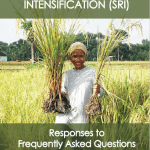
34 downloads
Title of document: The System of Rice Intensification (SRI): Responses to frequent asked questions Authors: Norman Uphoff Ministry/Government Agency/Organisation: Cornell University Year of publication: 2015 Geographic focus: World wide Url original document: http://sri.cals.cornell.edu/news/features/2016/featured040416.html Summary: Compared to a decade ago, many more persons – at least 10 million people, most of them farmers -- can now answer the question "What is SRI?" at least in general terms. However, most would probably not give very detailed answers, and many would like to know more about this strategy for raising the crop yield of rice, and now also other grains, legumes and vegetables, just by changing the way that these crops are managed, with minimal reliance on purchased inputs. Also by now, many more persons will at least have heard something about SRI and about its benefits for producers, for consumers, and for the environment. They may well be interested in a systematic introduction to this phenomenon which has demonstrated positive results in more than 50 countries around the world (http://sri.cals.cornell.edu/countries/index.html). So this book is written for both groups of potential readers, bringing together in one place much of the accumulated field experience and scientific research that makes the System of Rice Intensification and its derivations grouped under the broad heading of the System of Crop Intensification an unprecedented opportunity for enabling people to improve their lives in this 21st century. Read More
10 downloads
Title of document: Making Rice Production More Environmentally-Friendly Authors: Norman Uphoff and Frank B. Dazzo Ministry/Government Agency/Organisation: SRI International Network and Resources Center, International Programs, College of Agriculture and Life Sciences, Cornell University, Ithaca, NY 14853, USA Year of publication: 2016 Geographic focus: World wide Url original document: www.mdpi.com/journal/environment Summary: Irrigated rice production is one of the most essential agricultural activities for sustaining our global population, and at the same time, one of the agricultural sectors considered most eco-unfriendly. This is because it consumes a large share of available freshwater resources, competing with varied ecosystems as well as other economic sectors; its paddy fields are responsible for significant emission of greenhouse gases; and the reliance on chemical fertilizers and various agrochemicals contributes to pollution of soils and water systems. Read More

 Asia & Mekong Region
Asia & Mekong Region  Cambodia
Cambodia  Laos
Laos  Myanmar
Myanmar  Other
Other  Vietnam
Vietnam